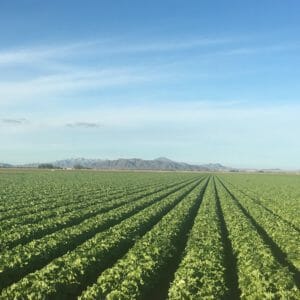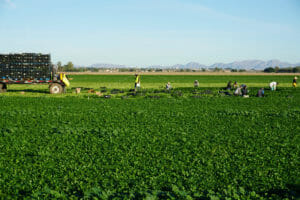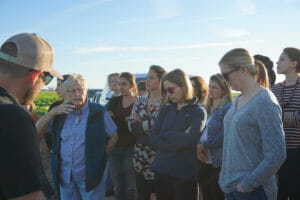As we enter our first stretch of 100 degree days, we here at the Swette Center are reminiscing back to the cool, crisp mornings of the winter. On one of those mornings the ASU grad leadership cohort had the pleasure of visiting several farms in the Yuma area. While many of these operations have packed up for their yearly transition to the summer season in Salinas, CA we can’t help but notice the stark contrast between our present COVID-19 reality and the relative calm of December.
Whether in Yuma or Salinas or Florida, produce farms all across the US are struggling to meet the demands of this new reality. Fortunately, if the people we met in Yuma are any indication, the folks behind these farms are strong, smart, and resilient and will certainly find a way forward with worker and food safety at the top of their minds.
This blog post was written by Arizona State University graduate student Annalise VanVranken. In addition to studying Food Policy and Sustainability Leadership at ASU, Annalise is a Strategy and Partnerships project manager for FoodCorps, where she works to connect kids to healthy food in schools all across the US.
Back in early December I was lucky enough to escape the chilly Northeast to travel to the place that boasts the Guinness World Record for the “Sunniest Place On Earth.” About halfway through our week-long immersion course focused on Arizona agriculture, as part of our Food Policy and Sustainability Leadership program, we arrived in the county that that puts fresh vegetables on the rest of the country’s tables all winter long.
While the list of things that I learned about Yuma agriculture through this eye-opening experience is as long as the endless fields of greens you’ll find there, I’ll leave you with the five tidbits that I found most fascinating:
They’re Not Dreaming of a White Christmas
You know what everyone loves on a snowy winter day? A big bowl of warm and cozy… salad? A large dish of fresh greens is usually not the preference for consumers in colder states in winter months, which is exactly why Yuma farmers long for mild winters on the east coast and in the Midwest. From November to March, the time during which they produce 90% of leafy vegetables in the US, freezing temperatures in other parts of the nation drive down demand from consumers leaving less of a market for Yuma’s products. That being said, they don’t mind at all if there’s a blizzard across California. That’ll help boost sales by narrowing the competition.
I Can’t Stand the Rain!
Like Tina Turner, producers in Yuma are not huge fans of rain. This might have been one of the biggest shocks to hear from the farmers we spoke with. Here are growers that produce thousands of acres of food in the middle of the desert and they don’t want it to rain? But that is exactly what they shared with us. When it rains, it’s unpredictable and can oversaturate the crops. The farmers explained that they prefer to control the water themselves, so that they can ensure the crops get water exactly when they need it. They’re able to do this because Yuma was one of the first places to utilize laser-guided land leveling that allows them to make perfectly flat fields to flood with the extensive canal system that’s in place. This canal system was originally based on the intricate irrigation systems created by the Quechan Tribe, who had been farming in this region for centuries. Fields as flat as a pool tables allow farmers to waste very little water because any overflow from the irrigation goes right back into the system.
Speaking of Water…
Yuma has some of the most senior water rights in the Colorado River Basin. Unfortunately, the water flow from the Colorado is now 1% of what it was about a century ago, thanks to overallocation and extended drought. Because of this, water is a hot topic in Arizona right now, particularly in Yuma because without water, farmers have no livelihood. Yuma county agriculture generates approximately 2.5 billion dollars in economic activity every year and 1 in 4 jobs are connected to agriculture. With 50% of their income coming from agriculture, it’s no surprise that Yuma farmers want to use water wisely, which is a huge part of why they invest in technology. Growers in Yuma track every bit of water that comes onto each one of their crops, whether it’s from the irrigation canals, rainfall or sprinklers, it’s measured. It’s estimated that current water efficiencies are at 75-80%, which is rare to find. Some even go as far as claiming that the Yuma County irrigation system is the most efficient in the world.
Bobbi McDermott has been breaking the glass ceiling in AZ agriculture since 1969
I was so excited to hear from several farmers during our visit to Yuma, but one of the highlights of this trip for me was being able to learn from the former District Conservationist for the United States Department of Agriculture, Bobbi McDermott. After graduating with a degree in agronomy, she took her first job in the Yuma field office of the Federal Soil Conservation Service. Within a few years she became the first woman promoted by the agency to a District Conservationist position at the age of just 24. Bobbi was a female leader in a male dominated field for over 40 years and she hasn’t stopped. Although she’s been retired since 2008, she still leads tours, just like she did for us, and continues to be an active educator in the agriculture community and to the broader public. With her incredibly deep knowledge and understanding of Yuma County soil and water, she’s become somewhat of a local celebrity among Yuma growers and in 2017 she was inducted into the Arizona Farming and Ranching Hall of Fame.
Food safety is their #1 priority.
As we were finishing up our tour, standing near a vast field of beautiful flatleaf parsley, we asked the farmers what they most wanted us to take away from our visit. They were all in agreement that we should know that safety is at the top of mind every single day with Yuma farmers. With what seems like constant and ongoing E. Coli outbreaks and recalls, Yuma growers are under a lot of pressure, but they wanted us to understand their trust in their systems and products. Not only are they under stringent food safety regulations like the Food Safety Modernization Act (FSMA), which establishes science-based guidelines for safe growing and harvesting practices for fresh produce that are based on Good Agricultural Practices (GAP), they go above and beyond what’s required. They shared that thanks to technology, farmers can now track a head of lettuce at the supermarket back to the field, and even to the specific row where it came from on the farm. Every farm has a food safety expert that guarantees protocols are followed on site. Safety and quality are the primary focus of every grower in Yuma County.
Once that point sank in, the farmers left us with a closing sentiment; they shared that they love what they do. They love feeding people and they want to be as sustainable as possible in order to keep doing what they are doing for many years to come.
As we navigate these uncertain times it is more important than ever to have a robust network of food and agriculture policy leaders to make sensible and responsible decisions. Could you be one of those people? Learn more about answering this call by checking out the Food Policy and Sustainability Leadership Program at ASU! Accepting applications for the 2020-2021 cohort now!


